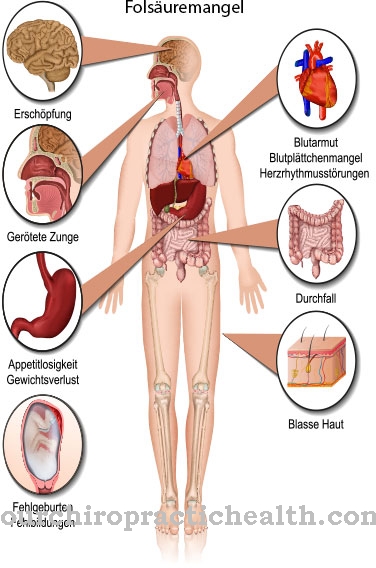At the Acute coronary no-flow phenomenon it is a complication that occurs in some cases during heart surgery. Basically, the phenomenon occurs with a very low frequency. The acute coronary no-flow phenomenon represents a condition that is associated with a serious threat to the lives of the affected patients. It is typical of the acute coronary no-flow phenomenon that the blood in one or more coronary vessels of the heart no longer flows.
What is the Acute Coronary No-Flow Phenomenon?

In principle, the acute coronary no-flow phenomenon is an extremely rare complication that primarily arises from surgical interventions in the heart area. In the English language, the disease is often referred to as an abrupt coronary no-flow among medical professionals. The most common abbreviation for the phenomenon is ACNF.
The acute coronary no-flow phenomenon is characterized primarily by the fact that the blood flow in the coronary vessels of the heart stagnates. The interrupted flow of blood is usually associated with a so-called transcoronary ablation of the hypertrophy of the septum. In any case, the acute coronary no-flow phenomenon is an acute emergency that threatens the life of the respective person and requires immediate intervention.
The acute coronary no-flow phenomenon is often triggered by spasms in the muscles of the blood vessels. An extremely high level of stress on the part of the patient prior to the heart operation seems to increase the risk of the acute coronary no-flow phenomenon.
causes
The acute coronary no-flow phenomenon only occurs in very few patients in the context of heart surgery. The phenomenon usually appears in the context of the so-called transcoronary ablation of septal hypertrophy. This medical procedure is often referred to by the acronym TASH. However, the complication develops in less than one percent of the operations.
The specific causes for the development of the acute coronary no-flow phenomenon have not yet been conclusively researched. What is certain, however, is that a spasm is developing in the area of the coronary arteries. Numerous patient observations indicate that the acute coronary no-flow phenomenon is probably often related to the enormous emotional stress of the person concerned before the surgical procedure.
In view of the high level of stress before the operation on the heart, some doctors assume that the messenger substances norepinephrine and adrenaline released during the stress phase may be involved in the development of the acute coronary no-flow phenomenon. However, this suspicion has not yet been confirmed by relevant scientific studies.
Symptoms, ailments & signs
The acute coronary no-flow phenomenon manifests itself in certain typical signs and symptoms in the affected patient. Usually the complication occurs as part of a surgical intervention in the area of the heart. However, this phenomenon is very unlikely to occur.
The characteristic main symptom of the acute coronary no-flow phenomenon is usually a lack of blood flow in one or even several coronary vessels of the heart. In the worst case, the flow of blood in all coronary vessels is interrupted. In principle, the phenomenon is a risky complication, so that emergency medical intervention is necessary as soon as possible. Because of the state of the lack of blood flow, the life of the person concerned is in acute danger.
Diagnosis & course
The diagnosis of the acute coronary no-flow phenomenon is made with regard to the characteristic symptoms of the life-threatening complication. Since the phenomenon occurs in the vast majority of cases during surgery in the area of the heart, an immediate diagnosis is usually required. This is usually carried out by the operating surgeon or the doctors present.
The lack of blood flow in the coronary blood vessels of the heart is usually a relatively clear indication of the presence of the acute coronary no-flow phenomenon. It is the task of the operating physicians to differentiate the complication from an interruption of the blood flow at the anterior interventricular branch. This problem arises in some cases when alcohol was injected incorrectly.The blood flow is blocked in isolation or moves in the direction of a side branch.
Complications
The no-flow phenomenon is itself a complication. In most cases it is life-threatening and, if left untreated, can lead to patient death. Due to the phenomenon, the blood flow in the coronary vessels of the heart stops completely. Only one vessel or several vessels can be affected. The no-flow phenomenon is treated acutely and usually during the surgical procedure.
If the blood flow stops for an extended period of time, the patient usually dies. The phenomenon mainly occurs when the patient has been incorrectly injected with alcohol. Treatment of the no-flow phenomenon is mostly done by injecting Urapidil. The medication is injected directly into the patient's coronary arteries, and in most cases other medications are also used.
Blood pressure must also be compared. It is usually not possible to prevent the no-flow phenomenon or to recognize it before the operation. Therefore, the treatment is necessary directly during the procedure. If the phenomenon is treated directly and correctly, there will be no further complications or consequential damage for the patient and life expectancy will not be affected.
When should you go to the doctor?
As a rule, the acute coronary no-flow phenomenon occurs immediately after an operation on the heart. For this reason, the treatment of this complaint is usually carried out immediately, so that a visit to the doctor is not necessary. Failure to promptly treat the coronary no-flow phenomenon will result in death. This leads to a lack of blood flow in the patient's heart. If this blood flow is not restored immediately, death usually occurs.
The patient is in mortal danger due to the acute coronary no-flow phenomenon and must be treated immediately for this reason. In most cases, the coronary no-flow phenomenon is directly noticeable through the lack of blood flow, so that the treating doctors can start the treatment immediately.
The blood flow can be restarted with the help of medication, so that the patient ultimately survives. If the treatment is quick and successful, there are no further particular complaints due to the coronary no-flow phenomenon. Life expectancy is not reduced by this disease either.
Doctors & therapists in your area
Treatment & Therapy
In the presence of the acute coronary no-flow phenomenon, it is urgently necessary to initiate emergency medical measures immediately. This is the only way to save the sick patient's life. In the majority of cases, the acute coronary no-flow phenomenon is treated by the doctors injecting the active ingredient urapidil into the affected patient.
The drug is usually used in high doses and is injected into the coronary arteries of the heart. In addition, the drug norepinephrine is injected into the patient's veins. In this way, the acute drop in blood pressure is compensated. Both measures are emergency medical methods that are only to be used in urgent cases. Otherwise, they themselves endanger the patient's life.
Outlook & forecast
The no-flow phenomenon is a very dangerous condition for the patient and must be treated in any case. Without treatment, the no-flow phenomenon usually leads to death. Because of the complaint, blood no longer flows into the coronary arteries of the heart. This can cause cardiac death to the patient if prompt treatment is not given. Since this is only a very rare phenomenon, which occurs mainly after heart surgery, the probability of the no-flow phenomenon is relatively low.
Treatment of the phenomenon is usually carried out with the help of drugs. A new surgical procedure is not necessary. The medication can alleviate the symptoms and allow blood to flow again. This stabilizes the patient's position immediately and there are no further restrictions or complaints. In most cases, the no-flow phenomenon occurs immediately after the operation, so that the treatment can also be carried out immediately afterwards. With quick and successful treatment, there are no further complications.
prevention
The acute coronary no-flow phenomenon cannot always be prevented. In principle, prevention has so far been difficult because the causes of the phenomenon are not yet fully known. Current observations suggest that any stress on the patient should be avoided prior to surgery.
You can do that yourself
The possibilities for self-help are very limited in the acute coronary no-flow phenomenon. The person concerned is normally not in a sufficient position in this phase of life to carry out changes or optimizations of their state of health. A recovery is also not possible without extensive medical care. Rather, complications or inadequate medical care can result in premature death.
In order to help yourself, you should, if possible, choose a treating doctor who enjoys the trust of the person concerned or their relatives. Close contact and exchange with the responsible doctors or nurses is necessary so that open questions can be clarified.
A comprehensive explanation of the disease is important so that surprises or misconduct can be avoided. The instructions and help given by the doctor or nursing staff should be followed so that no additional problems or further deterioration in health arise.
It is helpful if relatives are also informed about the situation and have a calming effect on the patient. Stress, conflicts, accusations or acting independently should be avoided if possible. The help offered by doctors or nurses is to be accepted so that the life-threatening condition can be overcome as quickly as possible. Aggressive behavior or time delays are to be avoided, as a quick and best possible stabilization of health is necessary.

.jpg)

.jpg)


.jpg)










.jpg)



.jpg)

.jpg)




